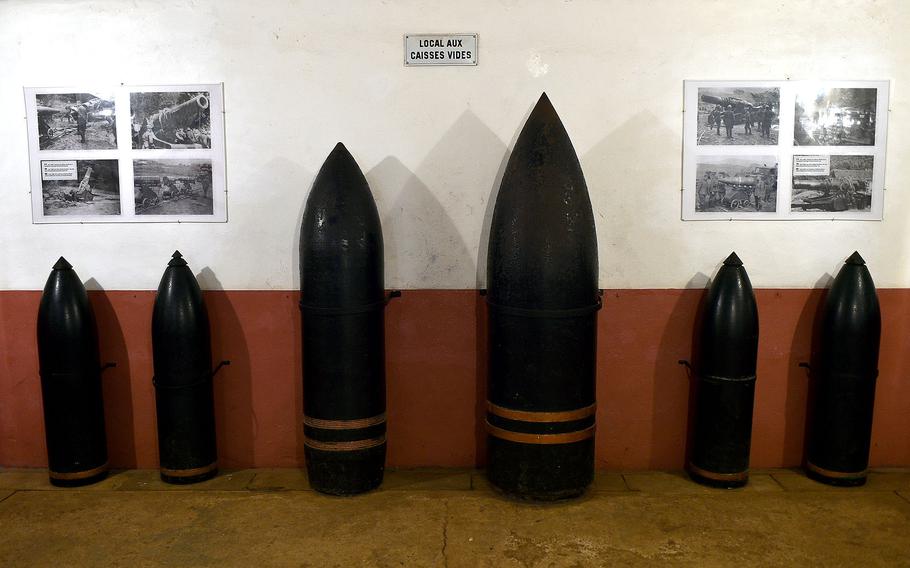
These artillery shells were among the options for the guns at Fort Schoenenbourg, a part of the famed Maginot Line near Hunspach, France, about 10 miles from the French-German border. (Matt Wagner/Stars and Stripes)
Perhaps unfairly, the chain of French World War II fortifications known as the Maginot Line has become a symbol of folly.
The line itself was well-built and formidable. The error lay in not anticipating German plans to bypass it.
The only folly to be found on a recent visit to the 1.8-mile Fort Schoenenbourg stretch of the line was my suggestion that we didn’t need the stroller for my friend’s toddler.
The fort is about 45 miles south of the U.S. bases in Kaiserslautern, just across the German-French border near the town of Hunspach. It was once a part of the defensive network championed in the 1920s by France’s minister of war, Andre Maginot.
At the entrance, a sign warned of a 132-step descent to reach the fort’s main facilities, roughly 90 feet underground, which is why I thought carrying the stroller made little sense.
But just past the gate, we found an elevator. Thus, the three adults had to carry the little guy through the labyrinth. I did my best to shoulder extra turns as penance.
Other than that mistake, the Fort Schoenenbourg experience was well worth the trip. I was unexpectedly impressed by the underground fortress, given the unflattering portrayal of Maginot’s namesake I remember from school.
The Maginot Line was supposed to force the Nazis to invade through the Netherlands and select parts of Belgium, giving French and Allied forces time to rally.
Ultimately, the plan failed because German forces attacked the lightly defended Ardennes forest, which the Allies had thought were impassable for large forces. The maneuver encircled the British and French in the north.
Seeing Fort Schoenenbourg, I can understand why the German high command avoided the Maginot Line. The place still seems impenetrable.
Despite facing some of the heaviest German bombardment, the fort wasn’t breached. It surrendered at the request of the French high command on July 1, 1940, nine days after France itself had capitulated.
Had the Germans tried to enter, the casualties would have been enormous. The six bunkers and two entrance blocks were heavily fortified, and walking down the corridors 85 years later, I could see how attackers would have been sitting ducks.
The fort also housed some unheard-of amenities for the time. It had its own electric plant with ventilators, maintenance equipment and a railway to move ammunition and supplies. Of the 620 men stationed there, at least 70 were highly skilled in electromechanical engineering.
With numerous personal touches throughout the facility, it felt less spartan than I’d imagined. Murals adorning many of the walls included depictions of Mickey Mouse and Josephine Baker, the American-born French entertainer whose exploits as a spy during World War II have been celebrated in both countries.
Early on, I saw a little alcove with a painting and a cross that acted as a prayer area. And to give a more World War II-era vibe, French big band music from the 1930s and ‘40s played from speakers.
You could see the effect World War I had on those involved. Chemical warfare was still on everybody’s minds, so the designers created areas for soldiers to wash off residue quickly.
The temperature is a consistent 53.6 degrees Fahrenheit, so warmer clothes are suggested. Comfortable walking shoes are a must.
Overall, it was an enlightening experience and a must-see for any World War II buff. Expect to spend multiple hours there because this isn’t a place you can blitz through.
And if any kids are taggling along, don’t err like I did. Fort Schoenenbourg is stroller-friendly.
Fort Schoenenbourg – Maginot Line
Address: Rue du Commander Reynier, Hunspach, France
Hours: 9:30 a.m.-4 p.m. seven days per week through August; in September, 2-4 p.m. Monday through Friday and 9:30 a.m.-4 p.m. Saturday and Sunday; in October, 2-4 p.m. Monday through Friday, 9:30-11 a.m. and 2-4 p.m. Saturday, Sunday and public holidays.
Prices: 10 euros for adults; 5 euros for children 6 to 17; children 5 and under, free.
Information: Phone: +33 3 88 80 96 19; Online: lignemaginot.com